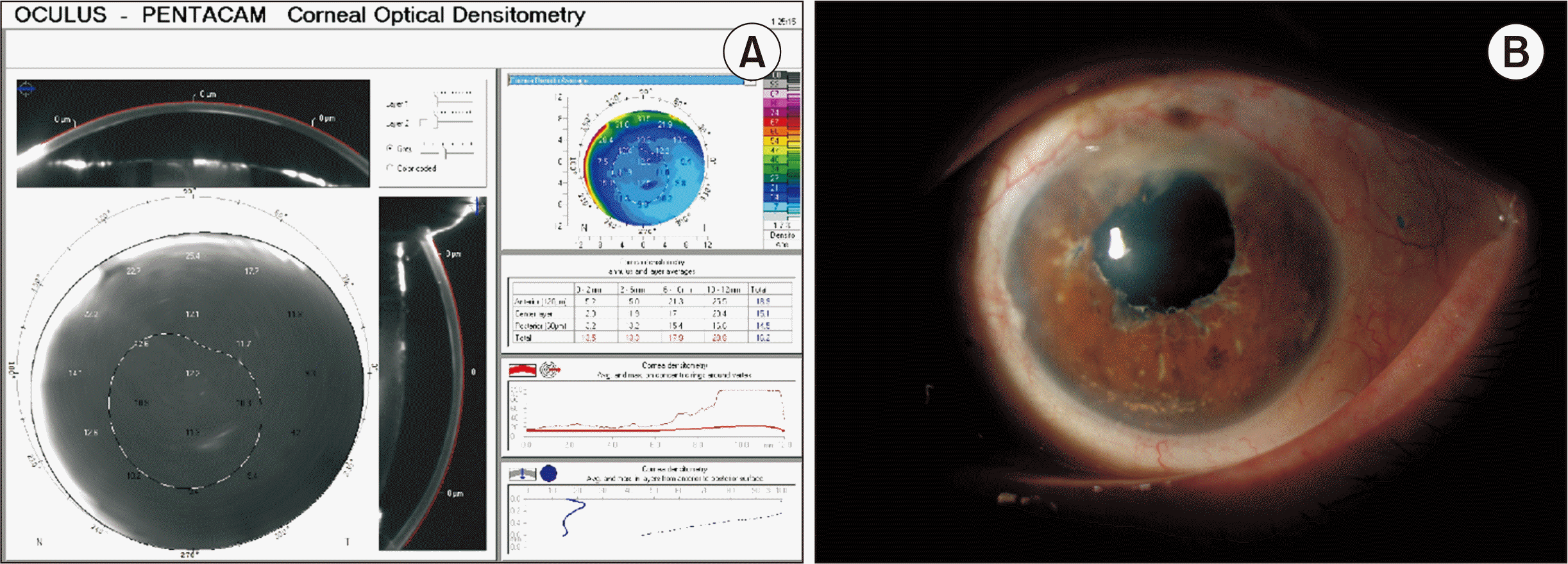2. Schaub F, Enders P, Bluhm C, Bachmann BO, Cursiefen C, Heindl LM. 2017; Two-year course of corneal densitometry after Descemet membrane endothelial keratoplasty. Am J Ophthalmol. 175:60–7. DOI:
10.1016/j.ajo.2016.11.019. PMID:
27986425.
3. Melles GR, Ong TS, Ververs B, van der Wees J. 2008; Preliminary clinical results of Descemet membrane endothelial keratoplasty. Am J Ophthalmol. 145:222–7. DOI:
10.1016/j.ajo.2007.09.021. PMID:
18061137.
4. Laaser K, Bachmann BO, Horn FK, Cursiefen C, Kruse FE. 2012; Descemet membrane endothelial keratoplasty combined with phacoemulsification and intraocular lens implantation: advanced triple procedure. Am J Ophthalmol. 154:47–55. DOI:
10.1016/j.ajo.2012.01.020. PMID:
22465365.
5. Patel SV, McLaren JW, Hodge DO, Bourne WM. 2008; The effect of corneal light scatter on vision after penetrating keratoplasty. Am J Ophthalmol. 146:913–9. DOI:
10.1016/j.ajo.2008.07.018. PMID:
18774549. PMCID:
PMC2612528.
6. Ní Dhubhghaill S, Rozema JJ, Jongenelen S, Ruiz Hidalgo I, Zakaria N, Tassignon MJ. 2014; Normative values for corneal densitometry analysis by Scheimpflug optical assessment. Invest Ophthalmol Vis Sci. 55:162–8. DOI:
10.1167/iovs.13-13236. PMID:
24327608.
7. Koh S, Maeda N, Nakagawa T, Nishida K. 2012; Quality of vision in eyes after selective lamellar keratoplasty. Cornea. 31 Suppl 1:S45–9. DOI:
10.1097/ICO.0b013e318269c9cd. PMID:
23038035.
8. Gellert A, Unterlauft JD, Rehak M, Girbardt C. 2022; Descemet membrane endothelial keratoplasty (DMEK) improves vision-related quality of life. Graefes Arch Clin Exp Ophthalmol. 260:3639–45. DOI:
10.1007/s00417-022-05711-9. PMID:
35612615. PMCID:
PMC9581807.
9. Gurnani B, Kaur K, Lalgudi VG, Tripathy K. 2023; Risk factors for Descemet membrane endothelial keratoplasty rejection: current perspectives-systematic review. Clin Ophthalmol. 17:421–40. DOI:
10.2147/OPTH.S398418. PMID:
36755886. PMCID:
PMC9899935.
11. Melles GR, Ong TS, Ververs B, van der Wees J. 2006; Descemet membrane endothelial keratoplasty (DMEK). Cornea. 25:987–90.
12. Yoeruek E, Bayyoud T, Hofmann J, Bartz-Schmidt KU. 2013; Novel maneuver facilitating Descemet membrane unfolding in the anterior chamber. Cornea. 32:370–3. DOI:
10.1097/ICO.0b013e318254fa06. PMID:
22820605.
13. Liarakos VS, Dapena I, Ham L, van Dijk K, Melles GR. 2013; Intraocular graft unfolding techniques in Descemet membrane endothelial keratoplasty. JAMA Ophthalmol. 131:29–35. DOI:
10.1001/2013.jamaophthalmol.4. PMID:
22965272.
14. Peraza-Nieves J, Baydoun L, Dapena I, Ilyas A, Frank LE, Luceri S, et al. 2017; Two-year clinical outcome of 500 consecutive cases undergoing Descemet membrane endothelial keratoplasty. Cornea. 36:655–60. DOI:
10.1097/ICO.0000000000001176. PMID:
28410548.
15. Monnereau C, Quilendrino R, Dapena I, Liarakos VS, Alfonso JF, Arnalich-Montiel F, et al. 2014; Multicenter study of Descemet membrane endothelial keratoplasty: first case series of 18 surgeons. JAMA Ophthalmol. 132:1192–8. DOI:
10.1001/jamaophthalmol.2014.1710. PMID:
24993643.
16. Turnbull AM, Tsatsos M, Hossain PN, Anderson DF. 2016; Determinants of visual quality after endothelial keratoplasty. Surv Ophthalmol. 61:257–71. DOI:
10.1016/j.survophthal.2015.12.006. PMID:
26708363.
17. van Dijk K, Droutsas K, Hou J, Sangsari S, Liarakos VS, Melles GR. 2014; Optical quality of the cornea after Descemet membrane endothelial keratoplasty. Am J Ophthalmol. 158:71–9. DOI:
10.1016/j.ajo.2014.04.008. PMID:
24784873.
18. Cabrerizo J, Livny E, Musa FU, Leeuwenburgh P, van Dijk K, Melles GR. 2014; Changes in color vision and contrast sensitivity after Descemet membrane endothelial keratoplasty for Fuchs endothelial dystrophy. Cornea. 33:1010–5. DOI:
10.1097/ICO.0000000000000216. PMID:
25119964.
19. Schoenberg ED, Price FW Jr, Miller J, McKee Y, Price MO. 2015; Refractive outcomes of Descemet membrane endothelial keratoplasty triple procedures (combined with cataract surgery). J Cataract Refract Surg. 41:1182–9. DOI:
10.1016/j.jcrs.2014.09.042. PMID:
26096520.
20. Machalinska A, Kuligowska A, Kaleta K, Kusmierz-Wojtasik M, Safranow K. 2021; Changes in corneal parameters after DMEK surgery: a swept-source imaging analysis at 12-month follow-up time. J Ophthalmol. 2021:3055722. DOI:
10.1155/2021/3055722. PMID:
34336256. PMCID:
PMC8321767.
21. Satue M, Idoipe M, Gavin A, Romero-Sanz M, Liarakos VS, Mateo A, et al. 2018; Early changes in visual quality and corneal structure after DMEK: does DMEK approach optical quality of a healthy cornea? J Ophthalmol. 2018:2012560. DOI:
10.1155/2018/2012560. PMID:
30345110. PMCID:
PMC6174748.
22. Rudolph M, Laaser K, Bachmann BO, Cursiefen C, Epstein D, Kruse FE. 2012; Corneal higher-order aberrations after Descemet's membrane endothelial keratoplasty. Ophthalmology. 119:528–35. DOI:
10.1016/j.ophtha.2011.08.034. PMID:
22197439.
23. Alnawaiseh M, Zumhagen L, Wirths G, Eveslage M, Eter N, Rosentreter A. 2016; corneal densitometry, central corneal thickness, and corneal central-to-peripheral thickness ratio in patients with Fuchs endothelial dystrophy. Cornea. 35:358–62. DOI:
10.1097/ICO.0000000000000711. PMID:
26655484.
24. Baratz KH, McLaren JW, Maguire LJ, Patel SV. 2012; Corneal haze determined by confocal microscopy 2 years after Descemet stripping with endothelial keratoplasty for Fuchs corneal dystrophy. Arch Ophthalmol. 130:868–74. DOI:
10.1001/archophthalmol.2012.73. PMID:
22410629.
25. Schaub F, Gerber F, Adler W, Enders P, Schrittenlocher S, Heindl LM, et al. 2019; Corneal densitometry as a predictive diagnostic tool for visual acuity results after Descemet membrane endothelial keratoplasty. Am J Ophthalmol. 198:124–9. DOI:
10.1016/j.ajo.2018.10.002. PMID:
30315754.




 PDF
PDF Citation
Citation Print
Print






 XML Download
XML Download